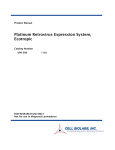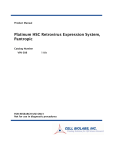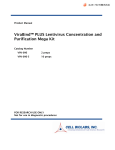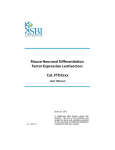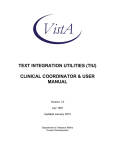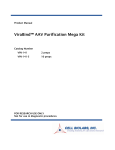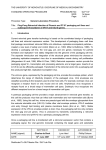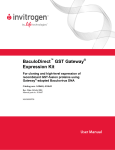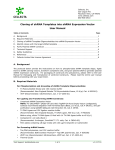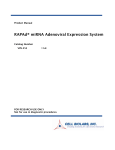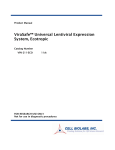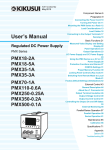Download Platinum ES/EC Retrovirus Expression System
Transcript
Product Manual Platinum ES/EC Retrovirus Expression System, Pantropic Catalog Number VPK-305 1 Kit FOR RESEARCH USE ONLY Not for use in diagnostic procedures Introduction Retroviral gene transfer is a technique for efficiently introducing stable, heritable genetic material into the genome of any dividing cell type. With Moloney Murine Leukemia Virus (MMLV) - based vectors, transduction efficiencies of >90% are achievable for most mitotic cell types, and the copy number per cell can be easily controlled by varying the multiplicity of infection. Current retroviral gene transfer technology is based on the coordinated design of packaging cell lines and retroviral expression vectors. The packaging cell line usually contains the viral gag, pol, and env genes, necessary for particle formation and replication, these genes are stably integrated into the packaging cell genome. Retroviral expression vectors provide the packaging signal ψ+, transcription and processing elements, and a target gene. Inserts of up to 6.5 kb can be efficiently packaged. Transfection of the retroviral vector into a packaging cell line produces high-titer, replicationincompetent virus (Table 1). The viral env gene, expressed by the packaging cell line, encodes the envelope protein, which determines the range of infectivity (tropism) of the packaged virus. Viral envelopes are classified according to the receptors used to enter host cells (Table 1). Ecotropic virus can recognize a receptor found on only mouse and rat cells. Amphotropic virus recognizes a receptor found on a broad range of mammalian cell types. Pantropic virus, such as retrovirus pseudo-typed with the envelope glycoprotein from the vesicular stomatitis virus (VSV-G), can infect both mammalian and nonmammalian cells. Unlike other viral envelope proteins, VSV-G mediates viral entry through lipid binding and plasma membrane fusion. However, stable expression of the VSV-G envelope protein is toxic, pantropic virus is usually produced by transiently cotransfecting a retroviral expression vector and pVSV-G into a pantropic packaging cell line expressing only the viral gag and pol genes. Conventional NIH-3T3 based retroviral packaging cell lines and Phoenix packaging cell lines have limited stability and produce low viral yields, mainly due to poor expression level of the retroviral structure proteins (gag, pol, env) in the packaging cells. The Platinum Packaging Cell Lines, potent retrovirus packaging cell lines based on the 293T cell line, were generated using novel packaging constructs with an EF1α promoter to ensure longer stability and high-yield retroviral structure protein expression (gag, pol, env). Platinum cells can be kept in good condition for at least 4 months in the presence of drug selection, and can produce retroviruses with an average titer of 1 x 106 infectious units/mL by transient transfection. In addition, replication competent retroviruses (RCR) are virtually nonexistent because only coding sequences of viral structural genes are used, avoiding any unnecessary retroviral sequences. Cell Biolabs’ Pantropic Platinum ES/EC Retrovirus Expression System provides a simple method to generate RCR-free pantropic retrovirus at high titer. The kit includes Plat-GP packaging cells, pCMVVSV-G, pMCs-Puro retrovirus expression vector and pMXs-GFP control vector. pMCs retroviral vector includes hybrid LTRs containing elements from both MMLV and PCMV and is capable of expressing genes in both EC and ES cells. 2 Amphotropic Ecotropic Pantropic* Human +++ N.S. +++ Mouse +++ +++ +++ Rat +++ +++ +++ Monkey +++ N.S. +++ Cat +++ N.S. +++ Dog +++ N.S. +++ + N.S +++ Bird N.S. N.S. +++ Fish N.S. N.S. +++ Frog N.S. N.S. +++ Insect N.S. N.S. +++ Mollusk N.S. N.S. +++ Hamster *Virus must be packaged with a pantropic envelope protein such as VSVG. N.S. = Not Suitable Table 1. Retrovirus Production in Packaging Cells and Virus Tropism Related Products 1. RV-101: Platinum-E Retroviral Packaging Cell Line, Ecotropic 2. RV-102: Platinum-A Retroviral Packaging Cell Line, Amphotropic 3. RV-103: Platinum-GP Retroviral Packaging Cell Line, Pantropic 4. RV-200: ViraDuctin™ Retrovirus Transduction Kit 5. VPK-120: QuickTiter™ Retroviral Quantitation Kit 6. VPK-300: Platinum Retroviral Expression System, Ecotropic 7. VPK-301: Platinum Retrovirus Expression System, Amphotropic 8. VPK-302: Platinum Retroviral Expression System, Pantropic 9. VPK-303: Platinum ES/EC Retroviral Expression System, Ecotropic 10. VPK-304: Platinum ES/EC Retroviral Expression System, Amphotropic 3 Kit Components 1. Plat-GP Retrovirus Packaging Cell Line (Part No. RV-103): One sterile tube – 1.0 mL, > 3 X 106 cells/mL in DMEM containing 20% FCS and 10% DMSO. 2. pCMV-VSV-G (Part No. RV-110): One sterile tube – 10 µg of pCMV-VSV-G plasmid at 0.25 µg/µL in TE 3. pMCs-Puro (Part No. RTV-041): One sterile tube – 10 µg of pMCs-Puro plasmid at 0.25 µg/µL in TE 4. pMCs-GFP (Part No. RTV-051): One sterile tube – 10 µg of pMCs-GFP plasmid at 0.25 µg/µL in TE Materials Not Supplied 1. Plat-GP Culture Medium: DMEM, 10% fetal calf serum (FCS), 10 µg/mL blasticidin, penicillin and streptomycin 2. Platinum Cell Freeze Medium: 70% DMEM, 20% FBS, 10% DMSO 3. Transfection Reagent 4. Plasmid Isolation Kit Storage Store Platinum Retrovirus Packaging Cell Line in liquid nitrogen and plasmids at -20ºC. Note: For best results begin culture of cells immediately upon receipt. If this is not possible, store at 80ºC until first culture. Store subsequent cultured cells long term in liquid nitrogen. Safety Considerations Remember that you will be working with samples containing infectious virus. Follow the recommended NIH guidelines for all materials containing BSL-2 organisms. Culturing Plat-GP Packaging Cell Line I. Establishing Plat-GP Cultures from Frozen Cells 1. After quickly thawing the cells in a 37 ºC water bath, immediately transfer the thawed cell suspension into a 15 mL tube containing 10 mL of culture medium. 2. Centrifuge the tube for 5 min at 1300 to 1500 rpm. 3. Discard the supernatant and break the cell pellet by finger tapping. 4. Add a few drops of culture medium with gentle shaking and finger tap the tube a few times. 5. Add 2 mL of culture medium to the tube and gently pipet the cell suspension up and down twice. 6. Transfer the cell suspension to a 10 cm culture dish containing 8 mL of culture medium. 7. Swirl the culture plate well to mix the cells, then incubate the cells for two to three days before expansion. Important Note: Don’t culture cells to complete confluence. Split cells 4X to 6X every two to three days when the culture reaches 70-90% confluence. 4 II. Splitting the Cells Note: Avoid forming bubbles as much as possible during this procedure. 1. Wash cells once with PBS. 2. Add 4 mL of 0.05% Trypsin/0.5 mM EDTA solution to a 10 cm dish and incubate at 37 ºC for 3-5 min. 3. Remove the cells from the dish surface by tapping the rim of the culture dish. 4. Transfer 10 mL of the culture medium to a 50 mL tube. 5. Using the same pipette with some residual culture medium, wash the dish surface gently three times in 4 mL of the Trypsin/EDTA solution. 6. Gently pipette the cell suspension up and down 7 times and transfer the cell suspension into the 50 mL tube containing 10 mL medium from step 4. 7. Centrifuge the cells for 5 min at 1300-1500 rpm. 8. Discard the supernatant and break the cell pellet by finger tapping. 9. Add a few drops of culture medium with gentle shaking and finger tap the tube a few times. 10. Add 5 mL of culture medium and gently pipet the cell suspension up and down twice. 11. Add 15 mL of culture medium, then count and seed the cells. Typically 107 cells can be harvested from one 10 cm culture dish. Retroviral Expression Vectors pMCs-Puro Cell Biolabs’ pMCs-Puro retroviral vector includes hybrid LTRs containing elements from both MMLV and PCMV and is capable of expressing genes in both EC and ES cells. The vector provides the viral package signal, transcription and processing elements, and MCS for cloning of a target gene. The vector contains the ampicillin-resistance gene for propagation and antibiotic selection in bacteria (Figure 1). Figure 1. Schematic representation of pMCs-Puro retroviral vector (Detailed plasmid sequences available at www.cellbiolabs.com). 5 5’-MCS: Enzyme Sites: 5’-PacI, BamHI, EcoRI-3’ MCS Sequence: TTAATTAAGGATCCCAGTGTGGTGGTACGGGAATTCAAGCTTGATC 3’-MCS: Enzyme Sites: 5’-EcoRI, XhoI, NotI-3’ MCS Sequence: GGCGGAATTCCAGCTGAGCGCCGGTCGCTACCATTACCAGTTGGTCTGGTGTCAAA AATAATAATAACCGGGCAGGCCATGTCTGCCCGTATTTCGCGTAAGGAAATCCATT ATGTACTATTTAAACTCGAGCGGCCGCCAGCACAGTGGTCGAC---SV40---puroGTCGAC--Note: For optimal expression, both 5’ MCS and 3’ MCS should be used to clone gene of interest and replace the stuffer sequence (partial LacZ) between them. pMCs-GFP The control vector contains the ampicillin-resistance gene, LTRs, package signal and GFP insert (Figure 2). Figure 2. Schematic representation of pMCs-GFP retroviral vector. 6 pCMV-VSV-G The envelope vector contains the ampicillin-resistance gene and CMV-driven VSV-G insert (Figure 3). Figure 3. Schematic representation of pCMV-VSV-G envelope vector. Retrovirus Production I. Transfection 1. Clone your target gene into a retroviral expression vector, or use the provided pMX-GFP control vector for control experiments. 2. Seed 2 x 106 cells in a 60 mm culture dish without antibiotics including puromycin and blasticidin one day before transfection. 3. After 16 to 24 hours, start transfection when the culture becomes 70-80% confluent. Note: We suggest transfecting cells with FuGENE® Transfection Reagent (Roche Applied Science) or Lipofectamine™ Plus (Invitrogen). For example, 1 μg pCMV-VSV-G plasmid and 2 μg retroviral expression plasmid are mixed with 9 μL FuGENE® Transfection Reagent according to the manufacturer’s recommendation. The mixed DNA-FuGENE® complex is added by dropwise into the culture media. 4. Harvest retroviral supernatant 48 hours after transfection. II. Selection of Stable Virus Producing Cell Lines 1. Plate transfected packaging cells in puromycin selection medium 24–36 hr after transfection. 2. Culture cells for one week with the appropriate antibiotic. 3. Isolate large, healthy colonies and transfer them to individual plates or wells. 4. Determine the viral supernatant titer with desired method and select the clones producing hightiter retrovirus. 5. Culture the selected clone, until cell culture reaches the desired culture volume. Store cell clones in liquid nitrogen. 7 6. Retaining one plate for the continuation of the culture. 7. Viral supernatants can then be harvested every 24 hr after cells reaches 60–80% confluence until cells are no longer viable. Storage of Viral Stock VSVG-pseudotyped retrovirus may be concentrated by 50,000g for 90 min and then stored in aliquots at -80ºC. Post-Packaging Considerations Packaging your retrovirus is only the first step to ensuring successful expression of your gene. The following steps should be considered prior to infection of your host cell: 1. Concentration and purification of your retrovirus: Because of the latent nature of retrovirus, it is imperative that your virus be highly concentrated before infecting your host cell. Also, impurities from your viral supernatant can decrease the efficiency of infection. We recommend using Cell Biolabs’ ViraBind™ Retrovirus Concentration and Purification Kit (Catalog # VPK-130). 2. Measure the titer of your retrovirus: This is an important step to ensure consistent viral transduction into your host cell. However, QPCR or stable clone counting can take as much as 1-2 weeks to perform. QuickTiter™ Retroviral Quantitation Kit (Catalog # VPK-120) uses exclusive technology to determine the retroviral titer in 2 hrs. 3. Use transduction reagents to increase infection efficiency: Many cells are difficult to infect with retrovirus, and without supplemental reagents transduction efficiencies can be low. Reagents such as Polybrene® can help, but are often insufficient. Cell Biolabs’ proprietary reagents in our ViraDuctin™ Retrovirus Transduction Kit (Catalog # RV-200) form a super-complex with your virus to increase transduction efficiencies by promoting virus and cell interaction. References 1. Miller, A. D. & Baltimore, C. (1986) Mol. Cell. Biol. 6:2895–2902. 2. Mann, R., Mulligan, R. C. and Baltimore, D. (1983) Cell 33:153–159. 3. Morita, S., Kojim, T., and Kitamura, T. (2000) Gene Therapy 7: 1063-1066. 4. Takahashi, K. and Yamanaka, S. (2006) Cell 126: 663-676. Recent Product Citation Kishida, T. et al. (2015). Reprogrammed functional brown adipocytes ameliorate insulin resistance and dyslipidemia in diet-induced obesity and type 2 diabetes. Stem Cell Reports. doi:10.1016/j.stemcr.2015.08.007. License Information This licensed product is intended for ACADEMIC, GOVERNMENT AND NON-PROFIT RESEARCH USE ONLY; not for use in diagnostic or therapeutic procedures. The product may not be transferred, sold, or otherwise provided to another laboratory except by an authorized distributor of Cell Biolabs, Inc. 8 Use of this product by Biotechnology and Pharmaceutical companies requires a license for all fields of use including research. Please contact: Director of Business Development Cell Biolabs, Inc. [email protected] Warranty These products are warranted to perform as described in their labeling and in Cell Biolabs literature when used in accordance with their instructions. THERE ARE NO WARRANTIES THAT EXTEND BEYOND THIS EXPRESSED WARRANTY AND CELL BIOLABS DISCLAIMS ANY IMPLIED WARRANTY OF MERCHANTABILITY OR WARRANTY OF FITNESS FOR PARTICULAR PURPOSE. CELL BIOLABS’ sole obligation and purchaser’s exclusive remedy for breach of this warranty shall be, at the option of CELL BIOLABS, to repair or replace the products. In no event shall CELL BIOLABS be liable for any proximate, incidental or consequential damages in connection with the products. Contact Information Cell Biolabs, Inc. 7758 Arjons Drive San Diego, CA 92126 Worldwide: +1 858-271-6500 USA Toll-Free: 1-888-CBL-0505 E-mail: [email protected] www.cellbiolabs.com 2008-2015: Cell Biolabs, Inc. - All rights reserved. No part of these works may be reproduced in any form without permissions in writing. 9









